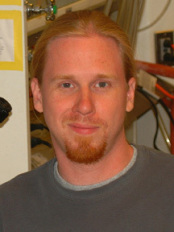Specialized iNANO Lecture: Design of soft material interfaces: From 'conventional' to 'covalent' assembly
David M. Lynn, Department of Chemical and Biological Engineering and Department of Chemistry, University of Wisconsin, USA
Info about event
Time
Location
iNANO Auditorium (1593-012), Gustav Wieds Vej 14, 8000 Aarhus C

David M. Lynn, Department of Chemical and Biological Engineering and Department of Chemistry, University of Wisconsin, USA
Design of soft material interfaces: From 'conventional' to 'covalent' assembly
Methods for the layer-by-layer assembly of polymers on surfaces provide useful and versatile approaches for the fabrication of soft material coatings. These approaches generally fall into one of two categories depending on the types of molecular interactions that are exploited to drive film growth—e.g., either (i) polyvalent weak interactions between mutually interacting polymers or (ii) the formation of covalent bonds between mutually reactive polymers. The latter ‘reactive’ or ‘covalent’ approaches offer several potential practical advantages, including the fact that they lead to covalently crosslinked coatings that can exhibit enhanced physical and chemical stability in complex media. In addition, the use of reactive polymers to drive assembly yields inherently reactive coatings that can be further functionalized to impart new surface or bulk properties. This presentation will discuss reactive approaches to the design of nanoporous polymer multilayers that provide unique opportunities to control the bulk and interfacial properties and functional behaviors of thin films and coatings. Our approach exploits the reactivity of azlactone-functionalized polymers, and leads to coatings with nanoscale and microscale pores and topographic features that can be readily functionalized by treatment with a broad range of chemical or biological amine-based nucleophiles. This approach enables the facile manipulation and patterning of secondary functionality that, when combined with the porous structures of these materials, enables the design of (i) new types extremely non-wetting surfaces, including soft superhydrophobic and extremely oil repellant materials, (ii) new classes of anti-fouling materials, including new approaches to the design of multifunctional ‘slippery’ oil-infused porous surfaces (SLIPS), and (iii) new platforms for the chemical protection and long-term release of water-soluble and water-sensitive agents in aqueous environments. Features that contribute to the development of porosity in these materials, aspects of physical robustness and novel self-healing behaviors that arise from that porosity, and other recent results demonstrating the potential utility of these porous polymer coatings in several applied chemical and biotechnological contexts will be discussed.
Short Biography
David M. Lynn was born in York, Pennsylvania, in 1972. He received a B.S. in Chemistry from the University of South Carolina in 1994 and a Ph.D. in Chemistry from the California Institute of Technology in 1999, where he worked under the supervision of Prof. Robert H. Grubbs. He pursued postdoctoral studies at MIT with Prof. Robert Langer, and then joined the faculty in the Departments of Chemical and Biological Engineering and Chemistry at the University of Wisconsin – Madison in 2002, where he is now the Duane H. and Dorothy M. Bluemke Professor of Chemical and Biological Engineering and a Vilas Distinguished Achievement Professor. He has received several research awards, including the Arnold and Mabel Beckman Foundation Young Investigator Award, an Alfred P. Sloan Foundation Fellowship, MIT Technology Review’s TR100 Award, and the inaugural Biomacromolecules/Macromolecules Young Investigator Award from the ACS Division of Polymer Chemistry.
Host: Associate professor Alexander Zelikin, iNANO & Dept. of Chemistry, Aarhus University